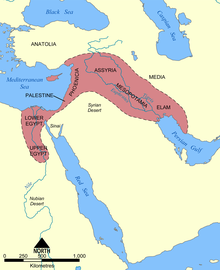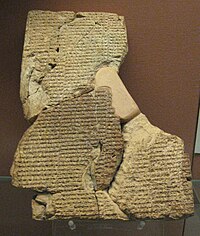Panbabylonism: Difference between revisions
m →top: fixed citation template(s) to remove page from Category:CS1 maint: Extra text & general fixes using AWB |
adding reference |
||
| Line 1: | Line 1: | ||
[[File:Fertile Crescent map.png|thumb|A map showing the generally defined area of the Fertile Crescent in red]] |
[[File:Fertile Crescent map.png|thumb|A map showing the generally defined area of the Fertile Crescent in red]] |
||
'''Panbabylonism''' is the school of thought that considered the cultures and religions of the [[Middle East]] and civilization in general to be ultimately derived from Babylonian myths which in turn they viewed as being based on [[Babylonian astronomy]], often in hidden ways. A related school of thought is the Bible-Babel school, which regarded the [[Hebrew Bible]] and [[Judaism]] to be directly derived from [[Mesopotamian religion|Mesopotamian (Babylonian) mythology]]; both are forms of [[hyperdiffusionism in archaeology]].<ref name=megaliths>{{cite book|last1=Brown|first1=Peter Lancaster|title=Megaliths, myths, and men : an introduction to astro-archaeology|date=2000|publisher=Dover Publications|location=Mineola, NY|isbn=9780486411453|edition=Dover|url=https://books.google.com/books?id=bHMV2-ZoUd8C&pg=PA267&lpg=PA267|page=267}}</ref> |
'''Panbabylonism''' (also known as '''Panbabylonianism''') is the school of thought that considered the cultures and religions of the [[Middle East]] and civilization in general to be ultimately derived from Babylonian myths which in turn they viewed as being based on [[Babylonian astronomy]], often in hidden ways.<ref>[[Crawford Howell Toy|Toy, Crawford H]]. (1910). [https://www.jstor.org/stable/3142227 ''Panbabylonianism'']. ''[[The Harvard Theological Review]]'' 3 (1): 47-84.</ref> |
||
A related school of thought is the Bible-Babel school, which regarded the [[Hebrew Bible]] and [[Judaism]] to be directly derived from [[Mesopotamian religion|Mesopotamian (Babylonian) mythology]]; both are forms of [[hyperdiffusionism in archaeology]].<ref name=megaliths>{{cite book|last1=Brown|first1=Peter Lancaster|title=Megaliths, myths, and men : an introduction to astro-archaeology|date=2000|publisher=Dover Publications|location=Mineola, NY|isbn=9780486411453|edition=Dover|url=https://books.google.com/books?id=bHMV2-ZoUd8C&pg=PA267&lpg=PA267|page=267}}</ref> |
|||
Both theories were popular in Germany, and the height of Panbabylonism was from the late 19th century to World War I. Panbabylonist thought largely disappeared from legitimate scholarship after the death of one of its greatest proponents, [[Hugo Winckler]], according to one author, particularly in reference to astrology.<ref name=megaliths/> |
Both theories were popular in Germany, and the height of Panbabylonism was from the late 19th century to World War I. Panbabylonist thought largely disappeared from legitimate scholarship after the death of one of its greatest proponents, [[Hugo Winckler]], according to one author, particularly in reference to astrology.<ref name=megaliths/> |
||
Revision as of 02:23, 24 October 2017

Panbabylonism (also known as Panbabylonianism) is the school of thought that considered the cultures and religions of the Middle East and civilization in general to be ultimately derived from Babylonian myths which in turn they viewed as being based on Babylonian astronomy, often in hidden ways.[1]
A related school of thought is the Bible-Babel school, which regarded the Hebrew Bible and Judaism to be directly derived from Mesopotamian (Babylonian) mythology; both are forms of hyperdiffusionism in archaeology.[2]
Both theories were popular in Germany, and the height of Panbabylonism was from the late 19th century to World War I. Panbabylonist thought largely disappeared from legitimate scholarship after the death of one of its greatest proponents, Hugo Winckler, according to one author, particularly in reference to astrology.[2]

See also
- Mesopotamian religion
- List of topics characterized as pseudoscience
- Christianity and Paganism
- Comparative mythology
- Comparative religion
- Sumerian King Alulim as biblical Adam
- The Two Babylons
References
- ^ Toy, Crawford H. (1910). Panbabylonianism. The Harvard Theological Review 3 (1): 47-84.
- ^ a b Brown, Peter Lancaster (2000). Megaliths, myths, and men : an introduction to astro-archaeology (Dover ed.). Mineola, NY: Dover Publications. p. 267. ISBN 9780486411453.
External links
- The Development, Heyday, and Demise of Panbabylonism by Gary D. Thompson
